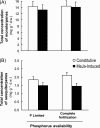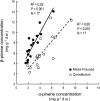Genetics, phosphorus availability, and herbivore-derived induction as sources of phenotypic variation of leaf volatile terpenes in a pine species
- PMID: 20952630
- PMCID: PMC2955752
- DOI: 10.1093/jxb/erq246
Genetics, phosphorus availability, and herbivore-derived induction as sources of phenotypic variation of leaf volatile terpenes in a pine species
Abstract
Oleoresin produced and stored in pine tree leaves provides direct resistance to herbivores, while leaf volatile terpenes (LVT) in the resin are also powerful airborne infochemicals. Resin concentration and profile show considerable spatial and temporal phenotypic variation within and among pine populations. LVT biochemistry is known to be under genetic control, and although LVT should be plastic to diverse abiotic and biotic environmental factors such as nutrient availability and herbivore attack, little is known about their relative contributions and interactive effects. The aim of this paper was to clarify whether reduced phosphorus availability could increase the LVT concentration and affect the expression of herbivore-derived induced defences, and how plasticity would contribute to the phenotypic variation of LVT. The constitutive and methyl-jasmonate (MeJa) induced LVT concentration and profile were analysed in 17 half-sib Pinus pinaster families growing under two levels of P-availability (complete and P-limited fertilization). Individual terpene concentrations showed large additive genetic variation, which was more pronounced in the control than in MeJa-induced pines. MeJa application did not affect the LVT concentration, but significantly modified the LVT profile by depleting the α-pinene content and reducing the sesquiterpene fraction. Low P-availability strongly reduced plant growth and foliar nutrient concentrations, but did not affect LVT concentration and profile, and did not interact with MeJa-induction. Results indicate a strong homeostasis of LVT concentration to P-availability, and minor changes in the LVT profile due to MeJa-induction. Genetic variation appears to be the main source of phenotypic variation affecting the LVT concentration in this pine species.
Figures



Similar articles
-
Induced defenses change the chemical composition of pine seedlings and influence meal properties of the pine weevil Hylobius abietis.Phytochemistry. 2016 Oct;130:99-105. doi: 10.1016/j.phytochem.2016.06.002. Epub 2016 Jul 11. Phytochemistry. 2016. PMID: 27417987
-
Effects of phosphorus availability and genetic variation of leaf terpene content and emission rate in Pinus pinaster seedlings susceptible and resistant to the pine weevil, Hylobius abietis.Plant Biol (Stuttg). 2012 Mar;14 Suppl 1:66-72. doi: 10.1111/j.1438-8677.2011.00492.x. Epub 2011 Jul 1. Plant Biol (Stuttg). 2012. PMID: 21972958
-
Induction of volatile terpene biosynthesis and diurnal emission by methyl jasmonate in foliage of Norway spruce.Plant Physiol. 2003 Jul;132(3):1586-99. doi: 10.1104/pp.103.021196. Plant Physiol. 2003. PMID: 12857838 Free PMC article.
-
Soil phosphorus mediates trade-offs between constitutive and induced defences in young pine trees.Planta. 2025 Aug 28;262(4):91. doi: 10.1007/s00425-025-04813-y. Planta. 2025. PMID: 40875075 Free PMC article.
-
Profiling methyl jasmonate-responsive transcriptome for understanding induced systemic resistance in whitebark pine (Pinus albicaulis).Plant Mol Biol. 2017 Nov;95(4-5):359-374. doi: 10.1007/s11103-017-0655-z. Epub 2017 Aug 31. Plant Mol Biol. 2017. PMID: 28861810
Cited by
-
Inducibility of Plant Secondary Metabolites in the Stem Predicts Genetic Variation in Resistance Against a Key Insect Herbivore in Maritime Pine.Front Plant Sci. 2018 Nov 21;9:1651. doi: 10.3389/fpls.2018.01651. eCollection 2018. Front Plant Sci. 2018. PMID: 30519249 Free PMC article.
-
HS-BAμE: A New Alternative Approach for VOCs Analysis-Application for Monitoring Biogenic Emissions from Tree Species.Molecules. 2023 Jan 25;28(3):1179. doi: 10.3390/molecules28031179. Molecules. 2023. PMID: 36770845 Free PMC article.
-
Secondary compounds enhance flammability in a Mediterranean plant.Oecologia. 2016 Jan;180(1):103-10. doi: 10.1007/s00442-015-3454-8. Epub 2015 Sep 28. Oecologia. 2016. PMID: 26416250
-
Effect of Soil Nutrient on Production and Diversity of Volatile Terpenoids from Plants.Curr Bioact Compd. 2012 Jan;8(1):71-79. doi: 10.2174/157340712799828188. Curr Bioact Compd. 2012. PMID: 23097639 Free PMC article.
-
Additive genetic variation in Pinus radiata bark chemistry and the chemical traits associated with variation in mammalian bark stripping.Heredity (Edinb). 2021 Dec;127(6):498-509. doi: 10.1038/s41437-021-00476-z. Epub 2021 Oct 18. Heredity (Edinb). 2021. PMID: 34663917 Free PMC article.
References
-
- Agrawal AA, Conner JK, Johnson MT, Wallsgrove R. Ecological genetics of induced plant defense against herbivores: additive genetic variation and costs of phenotypic plasticity. Evolution. 2002;56:2206–2213. - PubMed
-
- Arrabal C, Cortijo M, Fernández de Simón B, García Vallejo MC, Cadahía E. Differentiation among five Spanish Pinus pinaster provenances based on its oleoresin terpenic composition. Biochemical Systematics and Ecology. 2005;33:1007–1016.
-
- Baradat PH, Bernard-Dagan C, Fillon C, Marpeau A, Pauly G. Les terpènes du Pin maritime: aspects biologiques et génétiques. Il hérédité de la teneur en monoterpènes. Annals of Forest Science. 1972;29:307–334.
-
- Barnola LF, Cedeño A. Inter-population differences in the essential oils of Pinus caribaea needles. Biochemical Systematics and Ecology. 2000;28:923–931. - PubMed
-
- Bauce É Crépin M, Carisey N. Spruce budworm growth, development and food utilization on young and old balsam fir trees. Oecologia. 1994;97:499–507. - PubMed

